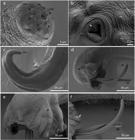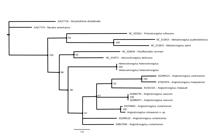|
Necator americanus
|
AJ417719 |
Human |
Small intestine |
China |
Hu et al. (2002)Hu M, Chilton NB, Gasser RB. The mitochondrial genomes of the human hookworms, Ancylostoma duodenale and Necator americanus (Nematoda: secernentea). Int J Parasitol 2002; 32(2): 145-158. http://dx.doi.org/10.1016/S0020-7519(01)00316-2. PMid:11812491.
http://dx.doi.org/10.1016/S0020-7519(01)...
|
|
Ancylostoma duodenale
|
AJ417718 |
Human |
Small intestine |
China |
Hu et al. (2002)Hu M, Chilton NB, Gasser RB. The mitochondrial genomes of the human hookworms, Ancylostoma duodenale and Necator americanus (Nematoda: secernentea). Int J Parasitol 2002; 32(2): 145-158. http://dx.doi.org/10.1016/S0020-7519(01)00316-2. PMid:11812491.
http://dx.doi.org/10.1016/S0020-7519(01)...
|
|
Aelurostrongylus abstrusus
|
JX519458 |
Felis catus
|
Lung |
- |
Jabbar et al. (2013a)Jabbar A, Jex AR, Mohandas N, Hall RS, Littlewood DTJ, Gasser RB. The mitochondrial genome of Aelurostrongylus abstrusus diagnostic, epidemiological and systematic implications. Gene 2013a; 516(2): 294-300. http://dx.doi.org/10.1016/j.gene.2012.10.072. PMid:23142387.
http://dx.doi.org/10.1016/j.gene.2012.10...
|
|
Heterostrongylus heterostrongylus
|
XXXXX |
Didelphis aurita
|
Lung |
Brazil |
Costa et al. (2016)Costa SF No, Oliveira Simões R, Mota ÉM, Val Vilela R, Lopes Torres EJ, Santos Barbosa H, et al. Lungworm Heterostrongylus heterostrongylus Travassos, 1925 from the black-eared opossum in South America: Morphologic, histopathological and phylogenetic aspects. Vet Parasitol 2016; 228: 144-152. http://dx.doi.org/10.1016/j.vetpar.2016.08.018. PMid:27692317.
http://dx.doi.org/10.1016/j.vetpar.2016....
|
|
H. heterostrongylus
|
XXXXX |
Didelphis aurita
|
Lung |
Brazil |
Costa et al. (2016)Costa SF No, Oliveira Simões R, Mota ÉM, Val Vilela R, Lopes Torres EJ, Santos Barbosa H, et al. Lungworm Heterostrongylus heterostrongylus Travassos, 1925 from the black-eared opossum in South America: Morphologic, histopathological and phylogenetic aspects. Vet Parasitol 2016; 228: 144-152. http://dx.doi.org/10.1016/j.vetpar.2016.08.018. PMid:27692317.
http://dx.doi.org/10.1016/j.vetpar.2016....
|
|
Metastrongylus pudendotectus
|
NC_013813 |
Pig |
Terminal bronchi in the lungs |
Estonia |
Jex et al. (2010)Jex AR, Hall RS, Littlewood DTJ, Gasser RB. An integrated pipeline for next-generation sequencing and annotation of mitochondrial genomes. Nucleic Acids Res 2010; 38(2): 522-533. http://dx.doi.org/10.1093/nar/gkp883. PMid:19892826.
http://dx.doi.org/10.1093/nar/gkp883...
|
|
Metastrongylus salmi
|
NC_013815 |
Pig |
Terminal bronchi in the lungs |
Estonia |
Jex et al. (2010)Jex AR, Hall RS, Littlewood DTJ, Gasser RB. An integrated pipeline for next-generation sequencing and annotation of mitochondrial genomes. Nucleic Acids Res 2010; 38(2): 522-533. http://dx.doi.org/10.1093/nar/gkp883. PMid:19892826.
http://dx.doi.org/10.1093/nar/gkp883...
|
|
Parafilaroides normani
|
NC_024656 |
Arctocephalus pusillus
|
Lung |
Australia |
Jabbar et al. (2014)Jabbar A, Mohandas N, Gasser RB. Characterisation of the mitochondrial genome of Parafilaroides normani (lungworm) of Arctocephalus pusillus doriferus (Australian fur seal). Parasitol Res 2014; 113(8): 3049-3055. http://dx.doi.org/10.1007/s00436-014-3968-8. PMid:24924434.
http://dx.doi.org/10.1007/s00436-014-396...
|
|
Protostrongylus rufescens
|
NC_023262 |
Sheep |
Lung |
Australia |
Jabbar et al. (2013b)Jabbar A, Mohandas N, Jex AR, Gasser RB. The mitochondrial genome of Protostrongylus rufescens– implications for population and systematic studies. Parasit Vectors 2013b; 6(1): 263. http://dx.doi.org/10.1186/1756-3305-6-263. PMid:24025317.
http://dx.doi.org/10.1186/1756-3305-6-26...
|
|
Angiostrongylus vasorum
|
GQ982735 |
Canis familiaris
|
Heart and pulmonary arteries |
United Kingdom |
Jefferies et al. (2010)Jefferies R, Shaw SE, Willesen J, Viney ME, Morgan ER. Elucidating the spread of the emerging canid nematode Angiostrongylus vasorum between Palaearctic and Nearctic ecozones. Infect Genet Evol 2010; 10(4): 561-568. http://dx.doi.org/10.1016/j.meegid.2010.01.013. PMid:20139034.
http://dx.doi.org/10.1016/j.meegid.2010....
|
|
A. vasorum
|
GQ982871 |
Vulpes vulpes
|
Heart and pulmonary arteries |
Portugal |
Jefferies et al. (2010)Jefferies R, Shaw SE, Willesen J, Viney ME, Morgan ER. Elucidating the spread of the emerging canid nematode Angiostrongylus vasorum between Palaearctic and Nearctic ecozones. Infect Genet Evol 2010; 10(4): 561-568. http://dx.doi.org/10.1016/j.meegid.2010.01.013. PMid:20139034.
http://dx.doi.org/10.1016/j.meegid.2010....
|
|
A. chabaudi
|
KU521521 |
Felis silvestris
|
Heart and pulmonary arteries |
Romania |
Gherman et al. (2016)Gherman CM, Ionică AM, D’Amico G, Otranto D, Mihalca AD. Angiostrongylus chabaudi (Biocca, 1957) in wildcat (Felis silvestris silvestris, S) from Romania. Parasitol Res 2016; 115(6): 2511-2517. http://dx.doi.org/10.1007/s00436-016-5032-3. PMid:27106235.
http://dx.doi.org/10.1007/s00436-016-503...
|
|
A. cantonensis
|
GQ398121 |
Rattus norvegicus
|
Pulmonary arteries |
China |
Lv et al. (2012)Lv S, Zhang Y, Zhang L, Liu Q, Liu HX, Hu L, et al. The complete mitochondrial genome of the rodent intra-arterial nematodes Angiostrongylus cantonensis and Angiostrongylus costaricensis. Parasitol Res 2012; 111(1): 115-123. http://dx.doi.org/10.1007/s00436-011-2807-4. PMid:22246368.
http://dx.doi.org/10.1007/s00436-011-280...
|
|
A. malaysiensis
|
KT947979 |
Rattus rattus
|
Heart and lung |
Malaysia |
Yong et al. (2016)Yong HS, Song SL, Eamsobhana P, Lim PE. Complete mitochondrial genome of Angiostrongylus malaysiensis lungworm and molecular phylogeny of Metastrongyloid nematodes. Acta Trop 2016; 161: 33-40. http://dx.doi.org/10.1016/j.actatropica.2016.05.002. PMid:27207134.
http://dx.doi.org/10.1016/j.actatropica....
|
|
A. costaricensis
|
KX378965 |
Nasua narica
|
Mesenteric vessels |
Costa Rica |
Santoro et al. (2016)Santoro M, Alfaro-Alarcón A, Veneziano V, Cerrone A, Latrofa MS, Otranto D, et al. The white-nosed coati (Nasua narica) is a naturally susceptible definitive host for the zoonotic nematode Angiostrongylus costaricensis in Costa Rica. Vet Parasitol 2016; 228: 93-95. http://dx.doi.org/10.1016/j.vetpar.2016.08.017. PMid:27692339.
http://dx.doi.org/10.1016/j.vetpar.2016....
|
|
A. costaricensis
|
KR827449 |
- |
Mesenteric vessels |
Costa Rica |
Yong et al., (2015)Yong HS, Song SL, Eamsobhana P, Goh SY, Lim PE, Chow WL, et al. Mitochondrial genome supports sibling species of Angiostrongylus costaricensis (Nematoda: angiostrongylidae). PLoS One 2015; 10(7): e0134581. http://dx.doi.org/10.1371/journal.pone.0134581. PMid:26230642.
http://dx.doi.org/10.1371/journal.pone.0...
|
|
A. costaricensis
|
GQ398122 |
- |
Mesenteric vessels |
Brazil |
Lv et al. (2012)Lv S, Zhang Y, Zhang L, Liu Q, Liu HX, Hu L, et al. The complete mitochondrial genome of the rodent intra-arterial nematodes Angiostrongylus cantonensis and Angiostrongylus costaricensis. Parasitol Res 2012; 111(1): 115-123. http://dx.doi.org/10.1007/s00436-011-2807-4. PMid:22246368.
http://dx.doi.org/10.1007/s00436-011-280...
|
|
A. minasensis n. sp. |
XXXXX |
Nasua nasua
|
Mesenteric vessels |
Brazil |
Present study |

 Thumbnail
Thumbnail
 Thumbnail
Thumbnail
 Thumbnail
Thumbnail
 Thumbnail
Thumbnail
 Thumbnail
Thumbnail




